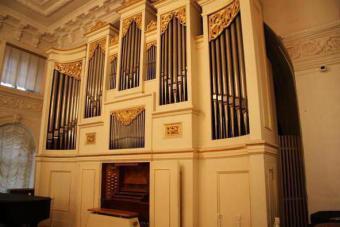Charlie Chaplin , byname of Sir Charles Spencer Chaplin , (born April 16, 1889, England-died December 25, 1977, Corsier-sur-Vevey, Switzerland), British comedian, producer, writer, director, and composer who is widely regarded as the greatest comic artist of the screen and one of the most important figures in motion-picture history.
Why is Charlie Chaplin important?
Comedian, actor, producer, writer, and director Charlie Chaplin is widely regarded as the greatest comic artist of the screen and one of the most important figures in . In 1972 he received a special for “the incalculable effect he has had on making motion pictures the art form of this century.”
What is Charlie Chaplin remembered for?
Charlie Chaplin is best remembered for his recurring character “the Little Tramp.” Outfitted in a too-small coat, too-large pants, floppy shoes, and a battered derby, Tramp was shunned by polite society and unlucky in love but ever a survivor. Audiences loved his cheekiness, his deflation of pomposity, his unexpected gallantry, and his resilience.
What were Charlie Chaplin’s achievements?
Charlie Chaplin starred in, wrote, and directed some of most memorable films in motion-picture history, including (1921), (1925), (1931), (1936), (1940), for which he was nominated for an Academy Award as best actor, Monsieur Verdoux (1947), and (1952).
What was Charlie Chaplin’s childhood like?
Brown BrothersIn truth, Chaplin did not always portray a tramp; in many of his films his character was employed as a waiter, store clerk, stagehand, fireman, and the like. His character might be better described as the quintessential misfit-shunned by polite society, unlucky in love, jack-of-all-trades but master of none. He was also a survivor, forever leaving past sorrows behind, jauntily shuffling off to new adventures. The Tramp’s appeal was universal: audiences loved his cheekiness, his deflation of pomposity, his casual savagery, his unexpected gallantry, and his resilience in the face of adversity. Some historians have traced the Tramp’s origins to Chaplin’s Dickensian childhood, while others have suggested that the character had its roots in the motto of Chaplin’s mentor, Fred Karno: “Keep it wistful , gentlemen, keep it wistful.” Whatever the case, within months after his movie debut, Chaplin was the screen’s biggest star.

His 35 Keystone comedies can be regarded as the Tramp’s gestation period, during which a caricature became a character. The films improved steadily once Chaplin became his own director. In 1915 he left Sennett to accept a $1,250-weekly contract at Essanay Studios. It was there that he began to inject elements of pathos into his comedy, notably in such shorts as The Tramp (1915) and Burlesque on Carmen (1915). He moved on to an even more lucrative job ($670,000 per year) at the Mutual Company Film Corporation. There, during an 18-month period, he made the 12 two-reelers that many regard as his finest films, among them such gems as One A.M. (1916), The Rink (1916), The Vagabond (1916), and Easy Street (1917). It was then, in 1917, that Chaplin found himself attacked for the first (though hardly the last) time by the press. He was criticized for not enlisting to fight in . To aid the war effort, Chaplin raised funds for the troops via bond drives.

In 1918 Chaplin jumped studios again, accepting a $1 million offer from the First National Film Corporation for eight shorts. That same year he married 16-year-old film extra Mildred Harris-the first in a procession of child brides. For his new studio he made shorts such as Shoulder Arms (1918) and The Pilgrim (1923) and his first starring feature, (1921), which starred the irresistible as the kid befriended and aided by the Little Tramp. Some have suggested that the increased dramatic content of those films is symptomatic of Chaplin’s efforts to justify the praise lavished upon him by the critical intelligentsia. A painstaking perfectionist, he began spending more and more time on the preparation and production of each film. In his personal life too, Chaplin was particular. Having divorced Mildred in 1921, Chaplin married in 1924 16-year-old Lillita MacMurray, who shortly would become known to the world as film star Lita Grey. (They would be noisily divorced in 1927.)

From 1923 through 1929 Chaplin made only three features: A Woman of Paris (1923), which he directed but did not star in (and his only drama); (1925), widely regarded as his masterpiece; and (1928), an underrated film that may rank as his funniest. All three were released by , the company cofounded in 1919 by Chaplin, husband-and-wife superstars and , and director . Of the three films, is one of the most-memorable films of the silent era. Chaplin placed the Little Tramp in the epic setting of the Yukon, amid bears, snowstorms, and a fearsome prospector (Mack Swain); his love interest was a beautiful dance-hall queen (Georgia Hale). The scene in which the Tramp must eat his shoe to stay alive epitomizes the film’s blend of rich comedy and well-earned pathos.

Чарли Чаплин биография на английском языке поможет подготовиться к уроку. Биография Чаплина на английском расскажет о жизни и творчестве известного киноактера.
Чарли Чаплин биография на английском
Charlie Chaplin was an English comic actor, filmmaker, and composer who rose to fame in the silent era. He is mostly famous for his screen persona «the t ramp» .
Born on April 16, 1889 in London, Chaplin is considered one of the most important figures in the history of the film industry. He had been a productive and creative film maker for about 75 years before he died in 1977.
Early life
Chaplin suffered from poverty and hardship in his childhood. He was sent to a workhouse twice before the age of nine. His mother struggled financially when his father was absent. When he was 14, his mother was sent to a mental asylum.
Career
Chaplin’s first performances were at music halls as a stage actor and comedian at the age of 19. He went to the USA where he was scouted for the film industry, and began appearing in 1914 for Keystone Studios . He soon developed the Tramp persona and formed a large fan base. Chaplin directed his own films from an early stage, and continued to hone his craft.. By 1918, he was one of the best known figures in the film industry.
Chaplin wrote, directed, produced, edited, starred in, and composed the music for most of his films. He was a perfectionist, and his financial independence enabled him to spend years on the development and production of a picture.
In 1919, Chaplin co-founded the distribution company United Artists , which gave him complete control over his films. His first feature-length was:
- The Kid (1921),
- A Woman of Paris (1923),
- The Gold Rush (1925),
- and The Circus (1928).
In the 1930s, Chaplin refused to move to sound films. He produced instead:
- City Lights (1931)
- and Modern Times (1936)
Both without dialogue.
Later his films became more political by producing , The Great Dictator (1940) where he satirized Adolf Hitler.
Controversy
The 1940s were a decade marked with controversy for Chaplin, and his popularity declined rapidly. He was accused of communist sympathies, while his involvement in a paternity suit and marriages to much younger women caused scandal. An FBI investigation was opened, and Chaplin was forced to leave the United States and settle in Switzerland.
His latest films
Charlie Chaplin abandoned the Tramp in his later films, which include Monsieur Verdoux (1947), Limelight (1952), A King in New York (1957), and A Countess from Hong Kong (1967).
Charlie Chaplin short biography
Charles Spencer Chaplin was born in 1889 in south London. His father died when he was a child, and the family didn’t have much money. Charlie first performed on the theatre stage at the age of five.
After he joined Frank Karno’s company, he went to the USA in 1914 and in his first year there he acted in 35 of Hollywood’s early films. These were “silent films”: before the invention of cinema sound — the actors couldn’t speak, but acted out their feelings in their faces and movements. Charlie Chaplin became one of the most famous actors in the world, and everyone knew and loved the role he played: a man with a black hat, big shoes, a little moustache and unusual walk.
The inventors of cinema were French, not Americans. The cinema became popular very quickly. In 1908 the USA had 10 000 cinemas.
Chaplin was born in England in 1889. His mother was so poor that she couldn’t look after him. But he started acting at the age of five and was soon a successful comic in the theater. When he went to America he got into films and became a star immediately.
In 1916, Chaplin earned $10 000 a week, and an extra $150 000 per film. In 1929 the age of the silent film came to an end. A new technology made it possible to record sound and pictures together. But some old directors couldn’t change their style. And some great silent actors had terrible voices. They couldn’t get parts in normal films.
Chaplin’s voice was good but he didn’t really want to talk in such films. His love was the silent films. In 1931 he made another classic film, City lights, but again it was silent. In the «Kid» (1921) Charlie Chaplin is a window repairer. The little boy helps him by breaking windows! In most of his films, Chaplin plays a poor man on the streets. But the actor was a millionaire. His silent films were perfect works of art. He created a language with his face and his body. Without words he could say everything.
Questions:
1. What is silent film?
2. Who was the inventor of it?
3. Chaplin was born in England, wasn’t he?
4. When did the age of silent films come to an end?
5. What language did Chaplin create?
Vocabulary:
inventor - изобретатель
immediately - сразу же
technology - технология
Чарли Чаплин
Основателями кинематографа были французы, не американцы. Кино очень быстро стало популярным. В 1908 году в США было 10 000 кинотеатров.
Чаплин родился в 1889 году в Англии. Его мать была такой бедной, что не могла его содержать. Но он начал играть в пятилетнем возрасте и впоследствии стал успешным комиком в театре. Когда он приехал в Америку и начал сниматься в фильмах и вскоре стал звездой. В 1916 году Чаплин зарабатывал десять тысяч долларов в неделю и дополнительно сто пятьдесят тысяч долларов за фильм. В 1929 году эра немого кино кончилась. Новые технологии сделали возможным воспроизводить звук и изображение одновременно. Но некоторые актеры не могли изменить свой стиль. А в некоторых выдающихся немых актеров был ужасный голос. Они не могли сниматься в нормальных фильмах.
Голос Чаплина был хорошим, но он не желал разговаривать в таких фильмах. Его любовью было немое кино. В 1931 году он снял другой классический фильм «Огни большого города», но опять же таким он был немым, В «Крохе» (1921) Чарли Чаплин - стекольщик. Маленький мальчик помогает ему, разбивая окна! В большинстве фильмов Чаплин играет бедного человека с улицы. Но актер был миллионером. Его немое кино было высоким произведением искусства. Он создал язык лица и тела. Он мог сказать все без слов.
Charlie Chaplin was a comedic British actor who became one of the biggest stars of the 20th century"s silent-film era.
Born on April 16, 1889, in London, England, Charlie Chaplin worked with a children"s dance troupe before making his mark on the big screen. His character "The Tramp" relied on pantomime and quirky movements to become an iconic figure of the silent-film era. Chaplin went on to become a director, making films such as City Lights and Modern Times, and co-founded the United Artists Corporation. He died in Corsier-sur-Vevey, Vaud, Switzerland, on December 25, 1977.
Famous for his character "The Tramp," the sweet little man with a bowler hat, mustache and cane, Charlie Chaplin was an iconic figure of the silent-film era and one of film"s first superstars, elevating the industry in a way few could have ever imagined.
Born Charles Spencer Chaplin in London, England, on April 16, 1889, Charlie Chaplin"s rise to fame is a true rags-to-riches story. His father, a notorious drinker, abandoned Chaplin, his mother and his older half-brother, Sydney, not long after Chaplin"s birth. That left Chaplin and his brother in the hands of their mother, a vaudevillian and music hall singer who went by the stage name Lily Harley.
Chaplin"s mother, who would later suffer severe mental issues and have to be committed to an asylum, was able to support her family for a few years. But in a performance that would introduce her youngest boy to the spotlight, Hannah inexplicably lost her voice in the middle of a show, prompting the production manager to push the five-year-old Chaplin, whom he"d heard sing, onto the stage to replace her.
Chaplin lit up the audience, wowing them with his natural presence and comedic angle (at one point he imitated his mother"s cracking voice). But the episode meant the end for Hannah. Her singing voice never returned, and she eventually ran out of money. For a time, Charlie and Sydney had to make a new, temporary home for themselves in London"s tough workhouses.
Armed with his mother"s love of the stage, Chaplin was determined to make it in show business himself, and in 1897, using his mother"s contacts, landed with a clog-dancing troupe named the Eight Lancashire Lads. It was a short stint, and not a terribly profitable one, forcing the go-getter Chaplin to make ends meet any way he could.
"I (was) newsvendor, printer, toymaker, doctor"s boy, etc., but during these occupational digressions, I never lost sight of my ultimate aim to become an actor," Chaplin later recounted. "So, between jobs I would polish my shoes, brush my clothes, put on a clean collar and make periodic calls at a theatrical agency."
Eventually other stage work did come his way. Chaplin made his acting debut as a pageboy in a production of Sherlock Holmes. From there he toured with a vaudeville outfit named Casey"s Court Circus and in 1908 teamed up with the Fred Karno pantomime troupe, where Chaplin became one of its stars as the Drunk in the comedic sketch A Night in an English Music Hall.
With the Karno troupe, Chaplin got his first taste of the United States, where he caught the eye of film producer Mack Sennett, who signed Chaplin to a contract for a $150 a week.
In 1914 Chaplin made his film debut in a somewhat forgettable one-reeler called Make a Living. To differentiate himself from the clad of other actors in Sennett films, Chaplin decided to play a single identifiable character, and "The Little Tramp" was born, with audiences getting their first taste of him in Kid Auto Races at Venice (1914).
Over the next year, Chaplin appeared in 35 movies, a lineup that included Tillie"s Punctured Romance, film"s first full-length comedy. In 1915 Chaplin left Sennett to join the Essanay Company, which agreed to pay him $1,250 a week. It is with Essanay that Chaplin, who by this time had hired his brother Sydney to be his business manager, rose to stardom.
During his first year with the company, Chaplin made 14 films, including The Tramp (1915). Generally regarded as the actor"s first classic, the story establishes Chaplin"s character as the unexpected hero when he saves the farmer"s daughter from a gang of robbers.
By the age of 26, Chaplin, just three years removed from his vaudeville days, was a superstar. He"d moved over to the Mutual Company, which paid him a whopping $670,000 a year. The money made Chaplin a wealthy man, but it didn"t seem to derail his artistic drive. With Mutual, he made some of his best work, including One A.M. (1916), The Rink (1916), The Vagabond (1916) and Easy Street (1917).
Through his work, Chaplin came to be known as a grueling perfectionist. His love for experimentation often meant countless takes, and it was not uncommon for him to order the rebuilding of an entire set. Nor was it uncommon for him to begin filming with one leading actor, realize he"d made a mistake in his casting and start again with someone new.
But the results were hard to refute. During the 1920s Chaplin"s career blossomed even more. During the decade he made some landmark films, including The Kid (1921), The Pilgrim (1923), A Woman in Paris (1923), The Gold Rush (1925), a movie Chaplin would later say he wanted to be remembered by, and The Circus (1928). The latter three were released by United Artists, a company Chaplin co-founded in 1919 with Douglas Fairbanks, Mary Pickford, and D.W. Griffith.
Chaplin became equally famous for his life off-screen. His affairs with actresses who had roles in his movies were numerous. Some, however, ended better than others.
In 1918 he quickly married 16-year-old Mildred Harris. The marriage lasted just two years, and in 1924 he wed again, to another 16-year-old, actress Lita Grey, whom he"d cast in The Gold Rush. The marriage had been brought on by an unplanned pregnancy, and the resulting union, which produced two sons for Chaplin (Charles Jr. and Sydney) was an unhappy one for both partners. They divorced in 1927.
In 1936, Chaplin married again, this time to a chorus girl who went by the film name of Paulette Goddard. They lasted until 1942. That was followed by a nasty paternity suit with another actress, Joan Barry, in which tests proved Chaplin was not the father of her daughter, but a jury still ordered him to pay child support.
In 1943, Chaplin married 18-year-old Oona O"Neill, the daughter of playwright Eugene O"Neill. Unexpectedly the two would go on to have a happy marriage, one that would result in eight children.
Nearing the end of his life, Chaplin did make one last visit to the United States in 1972, when he was given an honorary Academy Award. The trip came just five years after Chaplin"s final film, A Countess from Hong Kong (1967), the filmmaker"s first and only color movie. Despite a cast that included Sophia Loren and Marlon Brando, the film did poorly at the box office. In 1975, Chaplin received further recognition when he was knighted by Queen Elizabeth.
In the early morning hours of December 25, 1977, Charlie Chaplin died at his home in Corsier-sur-Vevey, Vaud, Switzerland. His wife, Oona, and seven of his children were at his bedside at the time of his passing. In a twist that might very well have come out of one of his films, Chaplin"s body was stolen not long after he was buried from his grave near Lake Geneva in Switzerland by two men who demanded $400,000 for its return. The men were arrested and Chaplin"s body was recovered 11 weeks later.
Данилюк Екатерина
Презентация по английскому языку "Charlie Chaplin" представлена ученицей 6 класса в рамках изучения темы "Learning more about each other" по УМК Enjoy English 5-6 Биболетовой М.З. В этой работе можно узнать много нового и интересного из биографии и фильмографии известного актера Чарли Чаплина.
Скачать:
Предварительный просмотр:
Чтобы пользоваться предварительным просмотром презентаций создайте себе аккаунт (учетную запись) Google и войдите в него: https://accounts.google.com
Подписи к слайдам:
Charlie Chaplin Biography
Charles Spencer Chaplin was born in Walworth, London, England on April 26th, 1889 to Charles and Hannah (Hill) Chaplin, both music hall performers, who were married on June 22nd, 1885. -
Chaplin began his official acting career at the age of eight, touring with The Eight Lancashire Lads. At 18 he began touring with Fred Karno"s vaudeville troupe, joining them on the troupe"s 1910 US tour. In November 1914 he left Keystone and signed on at Essanay, where he made 15 films. In 1916, he signed on at Mutual and made 12 films.
Chaplin"s life and career was full of scandal and controversy. His first big scandal was during World War I, during which time his loyalty to England, his home country, was questioned. He had never applied for US citizenship, but claimed that he was a "paying visitor" to the United States. Many British citizens called Chaplin a coward and a slacker.
Charlie Chaplin, considered to be one of the most pivotal stars of the early days of Hollywood, lived an interesting life both in his films and behind the camera. He is most recognized as an icon of the silent film era, often associated with his popular "Little Tramp" character; the man with the toothbrush mustache, bowler hat, bamboo cane, and a funny walk.
Another scandal occurred when Chaplin briefly dated 22-year-old Joan Barry. However, Chaplin"s relationship with Barry came to an end in 1942, after a series of harassing actions from her. In May of 1943 Barry returned to inform Chaplin that she was pregnant, and filed a paternity suit, claiming that the unborn child was his. During the 1944 trial blood tests proved that Chaplin was not the father, but at the time blood tests were inadmissible evidence and he was ordered to pay $75 a week until the child turned 21.
Conversely , when Chaplin and his family traveled to London for the premier of Limelight (1952), he was denied re-entry to the United States. In reality, the government had almost no evidence to prove that he was a threat to national security. He and his wife decided, instead, to settle in Switzerland . In 1921 Chaplin was decorated by the French government for his outstanding work as a filmmaker, and was elevated to the rank of Officer of the Legion of Honor in 1952. In 1972 he was honored with an Academy Award for his "incalculable effect in making motion pictures the art form of the century." In 1975 England"s Queen Elizabeth II knighted him.
Chaplin was married four times and had a total of 11 children. In 1918 he wed Mildred Harris, they had a son together, Norman Spencer Chaplin, who only lived three days. Chaplin and Mildred were divorced in 1920. He married Lita Grey in 1924, who had two sons, Charles Chaplin Jr. and Sydney Chaplin. They were divorced in 1927.
Chaplin"s later film The Great Dictator (1940), which was his first "talkie", also created a stir. In the film Chaplin plays a humorous caricature of Adolf Hitler. Some thought the film was poorly done and in bad taste. However, it grossed over $5 million and earned five Academy Award Nominations.
Chaplin"s other works included musical scores he composed for many of his films. He also authored two autobiographical books, "My Autobiography" in 1964 and its companion volume, "My Life in Pictures" in 1974. Chaplin died of natural causes on December 25, 1977 at his home in Switzerland.
In 1978, Chaplin"s corpse was stolen from its grave and was not recovered for three months; he was re-buried in a vault surrounded by cement.
Charlie Chaplin was considered one of the greatest filmmakers in the history of American cinema, whose movies were and still are popular throughout the world, and have even gained notoriety as time progresses. His films show, through the Little Tramp"s positive outlook on life in a world full of chaos, that the human spirit has and always will remain the same
Презентацию выполняла: Данилюк Екатерина 6 «а» класса МБОУ СОШ №8
Список литературы http://www.charliechaplin.com / http://ru.wikipedia.org/wiki/%D7%E0%EF%EB%E8%ED,_% D7%E0%F0%EB%FC%E7 http://www.kinopoisk.ru/name/78810 / http://images.yandex.ru/yandsearch?text=% D1%87%D0%B0%D1%80%D0%BB%D0%B8%20%D1%87%D0%B0%D0%BF%D0%BB%D0%B8%D0%BD%20%D1%84%D0%BE%D1%82%D0%BE&img_url=http%3A%2F%2Fimg11.nnm.ru%2F8%2F5%2F8%2F2%2F6%2F6082a2c6e6434b373eb71dd7ea2.jpg&pos=0&rpt=simage&lr=213&noreask=1&source=wiz http://images.yandex.ru/yandsearch?source=wiz&uinfo=sw-1003-sh-627-fw-778-fh-448-pd-1&p=1&text=% D1%87%D0%B0%D1%80%D0%BB%D0%B8%20%D1%87%D0%B0%D0%BF%D0%BB%D0%B8%D0%BD%20%D1%84%D0%BE%D1%82%D0%BE&noreask=1&pos=31&rpt=simage&lr=213&img_url=http%3A%2F%2Fimg0.liveinternet.ru%2Fimages%2Fattach%2Fb%2F3%2F21%2F241%2F21241793_182.jpg





